tyre pressure MITSUBISHI L200 2015 Owner's Manual (in English)
[x] Cancel search | Manufacturer: MITSUBISHI, Model Year: 2015, Model line: L200, Model: MITSUBISHI L200 2015Pages: 418, PDF Size: 25.8 MB
Page 2 of 418
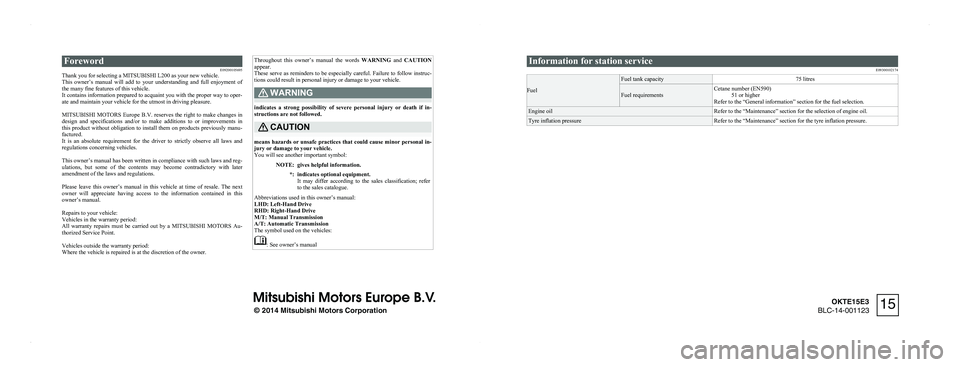
ForewordE09200105695
Thank you for selecting a MITSUBISHI L200 as your new vehicle.
This owner’s manual will add to your understanding and full enjoyment of
the many fine features of this vehicle.
It contains information prepared to acquaint you with the proper way to oper-
ate and maintain your vehicle for the utmost in driving pleasure.
MITSUBISHI MOTORS Europe B.V. reserves the right to make changes in
design and specifications and/or to make additions to or improvements in
this product without obligation to install them on products previously manu- factured.
It is an absolute requirement for the driver to strictly observe all laws and
regulations concerning vehicles.
This owner’s manual has been written in compliance with such laws and reg- ulations, but some of the contents may become contradictory with later amendment of the laws and regulations.
Please leave this owner’s manual in this vehicle at time of resale. The next
owner will appreciate having access to the information contained in this
owner’s manual.
Repairs to your vehicle:
Vehicles in the warranty period:
All warranty repairs must be carried out by a MITSUBISHI MOTORS Au-
thorized Service Point.
Vehicles outside the warranty period:
Where the vehicle is repaired is at the discretion of the owner.
Throughout this owner’s manual the words WARNING and CAUTION
appear.
These serve as reminders to be especially careful. Failure to follow instruc-
tions could result in personal injury or damage to your vehicle.WARNING
indicates a strong possibility of severe personal injury or death if in- structions are not followed.
CAUTION
means hazards or unsafe practices that could cause minor personal in-
jury or damage to your vehicle.
You will see another important symbol:
NOTE:gives helpful information.*:indicates optional equipment.
It may differ according to the sales classification; refer to the sales catalogue.
Abbreviations used in this owner’s manual:
LHD: Left-Hand Drive
RHD: Right-Hand Drive
M/T: Manual Transmission
A/T: Automatic Transmission
The symbol used on the vehicles:
: See owner’s manual
Information for station service
E09300102174
Fuel
Fuel tank capacity75 litresFuel requirementsCetane number (EN590)51 or higher
Refer to the “General information” section for the fuel selection.Engine oilRefer to the “Maintenance” section for the selection of engine oil.Tyre inflation pressureRefer to the “Maintenance” section for the tyre inflation pressure.
© 2014 Mitsubishi Motors Corporation
15
OKTE15E3
BLC-14-001123
Page 19 of 418
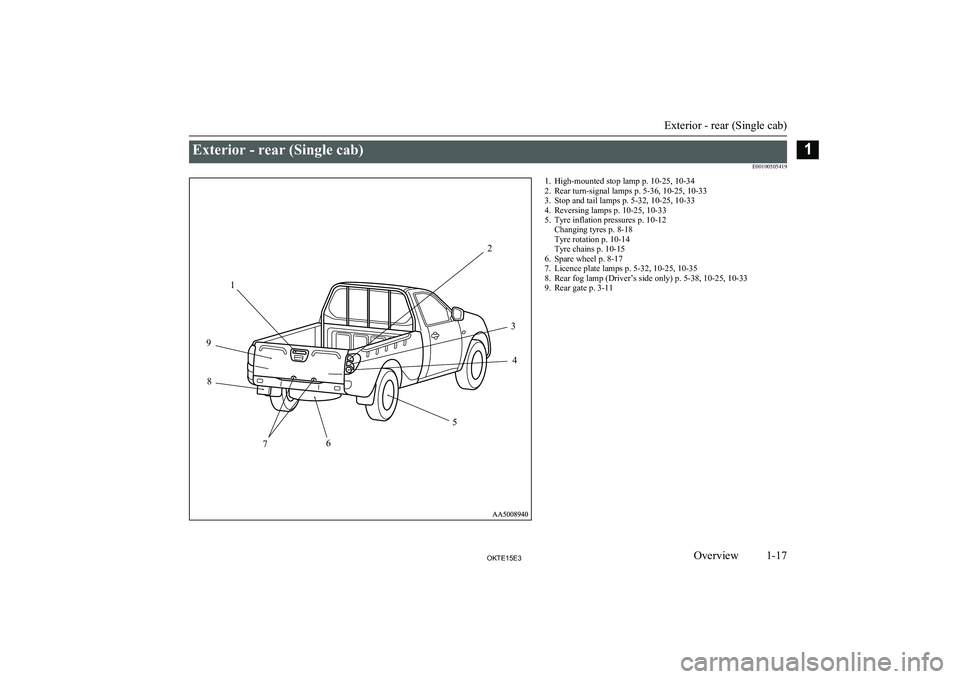
Exterior - rear (Single cab)E00100505419
1234567891. High-mounted stop lamp p. 10-25, 10-34
2. Rear turn-signal lamps p. 5-36, 10-25, 10-33
3. Stop and tail lamps p. 5-32, 10-25, 10-33
4. Reversing lamps p. 10-25, 10-33
5. Tyre inflation pressures p. 10-12 Changing tyres p. 8-18
Tyre rotation p. 10-14
Tyre chains p. 10-15
6. Spare wheel p. 8-17
7. Licence plate lamps p. 5-32, 10-25, 10-35
8. Rear fog lamp (Driver’s side only) p. 5-38, 10-25, 10-33
9. Rear gate p. 3-11
Exterior - rear (Single cab)
1-17OKTE15E3Overview1
Page 21 of 418

Exterior - rear (Club cab)E001005050571. Rear turn-signal lamps p. 5-36, 10-25, 10-33
2. Stop and tail lamps p. 5-32, 10-25, 10-33
3. Reversing lamps p. 10-25, 10-33
4. Tyre inflation pressures p. 10-12 Changing tyres p. 8-18
Tyre rotation p. 10-14
Tyre chains p. 10-15
5. Spare wheel p. 8-17
6. Licence plate lamps Type 1 p. 5-32, 10-25, 10-35
7. Rear fog lamp (Driver’s side only) Type 2* p. 5-38, 10-25, 10-33
8. Rear fog lamp (Driver’s side only) Type 1* p. 5-38, 10-25, 10-33
9. Rear gate p. 3-11
10. High-mounted stop lamp p. 10-25, 10-34
Exterior - rear (Club cab)
1-19OKTE15E3Overview112
3
4
5
6
7 8
9
10
Page 23 of 418

Exterior - rear (Double cab)E001005050601. Rear turn-signal lamps p. 5-36, 10-25, 10-33
2. Stop and tail lamps p. 5-32, 10-25, 10-33
3. Reversing lamps p. 10-25, 10-33
4. Tyre inflation pressures p. 10-12 Changing tyres p. 8-18
Tyre rotation p. 10-14
Tyre chains p. 10-15
5. Spare wheel p. 8-17
6. Licence plate lamps Type 1 p. 5-32, 10-25, 10-35
7. Rear fog lamp (Driver’s side only) Type 2* p. 5-38, 10-25, 10-33
8. Rear fog lamp (Driver’s side only) Type 1* p. 5-38, 10-25, 10-33
9. Rear gate p. 3-11
10. High-mounted stop lamp p. 10-25, 10-34
Exterior - rear (Double cab)
1-21OKTE15E3Overview112
3
4
5
6
7 8
9
10
Page 134 of 418
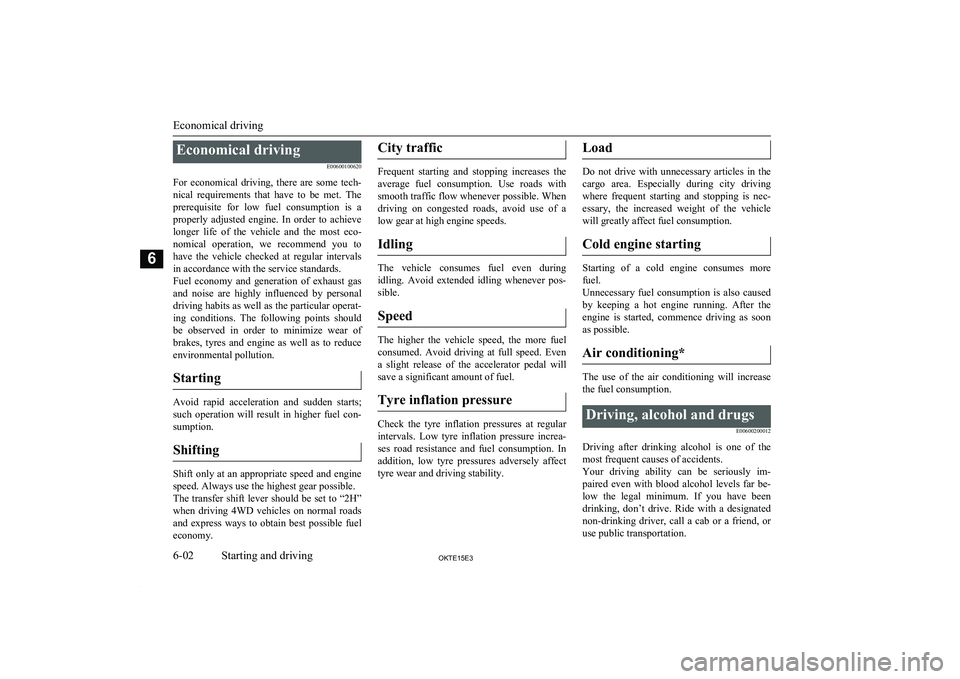
Economical drivingE00600100620
For economical driving, there are some tech- nical requirements that have to be met. Theprerequisite for low fuel consumption is a
properly adjusted engine. In order to achieve longer life of the vehicle and the most eco- nomical operation, we recommend you tohave the vehicle checked at regular intervals in accordance with the service standards.
Fuel economy and generation of exhaust gas
and noise are highly influenced by personal
driving habits as well as the particular operat- ing conditions. The following points shouldbe observed in order to minimize wear of
brakes, tyres and engine as well as to reduce
environmental pollution.
Starting
Avoid rapid acceleration and sudden starts;
such operation will result in higher fuel con-
sumption.
Shifting
Shift only at an appropriate speed and engine speed. Always use the highest gear possible.
The transfer shift lever should be set to “2H” when driving 4WD vehicles on normal roads
and express ways to obtain best possible fuel economy.
City traffic
Frequent starting and stopping increases the
average fuel consumption. Use roads with smooth traffic flow whenever possible. When driving on congested roads, avoid use of a
low gear at high engine speeds.
Idling
The vehicle consumes fuel even during
idling. Avoid extended idling whenever pos- sible.
Speed
The higher the vehicle speed, the more fuel
consumed. Avoid driving at full speed. Even a slight release of the accelerator pedal will
save a significant amount of fuel.
Tyre inflation pressure
Check the tyre inflation pressures at regularintervals. Low tyre inflation pressure increa-ses road resistance and fuel consumption. In addition, low tyre pressures adversely affect tyre wear and driving stability.
Load
Do not drive with unnecessary articles in the
cargo area. Especially during city driving where frequent starting and stopping is nec-
essary, the increased weight of the vehicle will greatly affect fuel consumption.
Cold engine starting
Starting of a cold engine consumes morefuel.
Unnecessary fuel consumption is also caused by keeping a hot engine running. After the
engine is started, commence driving as soon
as possible.
Air conditioning*
The use of the air conditioning will increase the fuel consumption.
Driving, alcohol and drugs
E00600200012
Driving after drinking alcohol is one of the
most frequent causes of accidents.
Your driving ability can be seriously im- paired even with blood alcohol levels far be-
low the legal minimum. If you have been drinking, don’t drive. Ride with a designated non-drinking driver, call a cab or a friend, or
use public transportation.
Economical driving
6-02OKTE15E3Starting and driving6
Page 171 of 418
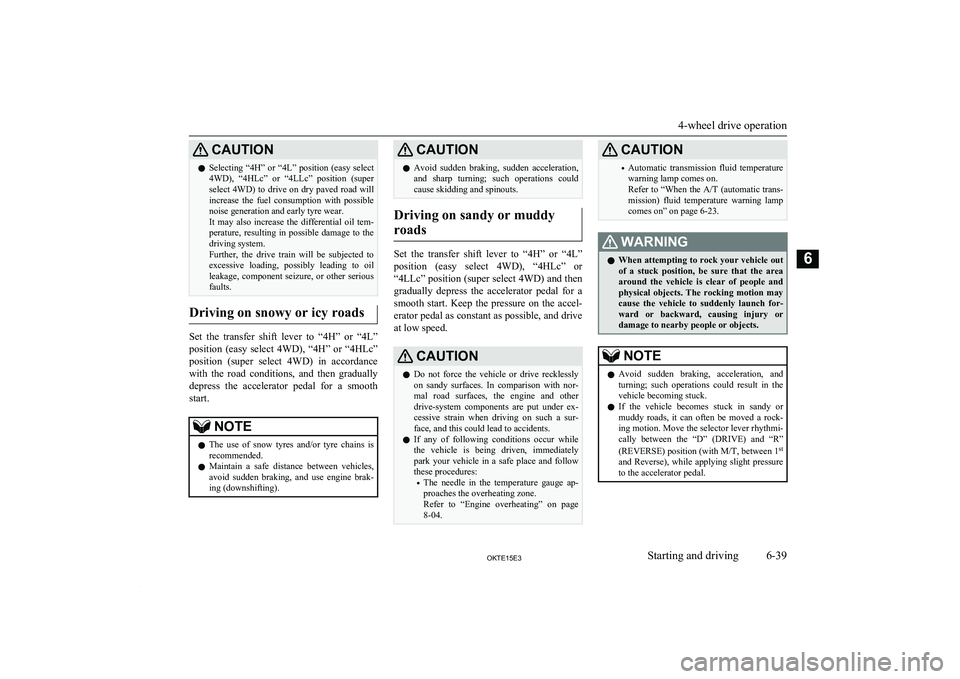
CAUTIONlSelecting “4H” or “4L” position (easy select
4WD), “4HLc” or “4LLc” position (super
select 4WD) to drive on dry paved road will
increase the fuel consumption with possible noise generation and early tyre wear.
It may also increase the differential oil tem- perature, resulting in possible damage to the
driving system.
Further, the drive train will be subjected to excessive loading, possibly leading to oilleakage, component seizure, or other serious faults.
Driving on snowy or icy roads
Set the transfer shift lever to “4H” or “4L”
position (easy select 4WD), “4H” or “4HLc” position (super select 4WD) in accordance
with the road conditions, and then gradually
depress the accelerator pedal for a smooth start.
NOTEl The use of snow tyres and/or tyre chains is
recommended.
l Maintain a safe distance between vehicles,
avoid sudden braking, and use engine brak-
ing (downshifting).CAUTIONl Avoid sudden braking, sudden acceleration,
and sharp turning; such operations could
cause skidding and spinouts.
Driving on sandy or muddy
roads
Set the transfer shift lever to “4H” or “4L”
position (easy select 4WD), “4HLc” or “4LLc” position (super select 4WD) and then
gradually depress the accelerator pedal for a
smooth start. Keep the pressure on the accel-
erator pedal as constant as possible, and drive at low speed.
CAUTIONl Do not force the vehicle or drive recklessly
on sandy surfaces. In comparison with nor-
mal road surfaces, the engine and other
drive-system components are put under ex- cessive strain when driving on such a sur-
face, and this could lead to accidents.
l If any of following conditions occur while
the vehicle is being driven, immediately park your vehicle in a safe place and follow these procedures:
• The needle in the temperature gauge ap-
proaches the overheating zone.
Refer to “Engine overheating” on page
8-04.CAUTION• Automatic transmission fluid temperature
warning lamp comes on.
Refer to “When the A/T (automatic trans-
mission) fluid temperature warning lamp comes on” on page 6-23.WARNINGl When attempting to rock your vehicle out
of a stuck position, be sure that the area
around the vehicle is clear of people and physical objects. The rocking motion may
cause the vehicle to suddenly launch for- ward or backward, causing injury or damage to nearby people or objects.NOTEl Avoid sudden braking, acceleration, and
turning; such operations could result in thevehicle becoming stuck.
l If the vehicle becomes stuck in sandy or
muddy roads, it can often be moved a rock-
ing motion. Move the selector lever rhythmi- cally between the “D” (DRIVE) and “R”
(REVERSE) position (with M/T, between 1 st
and Reverse), while applying slight pressure
to the accelerator pedal.
4-wheel drive operation
6-39OKTE15E3Starting and driving6
Page 174 of 418
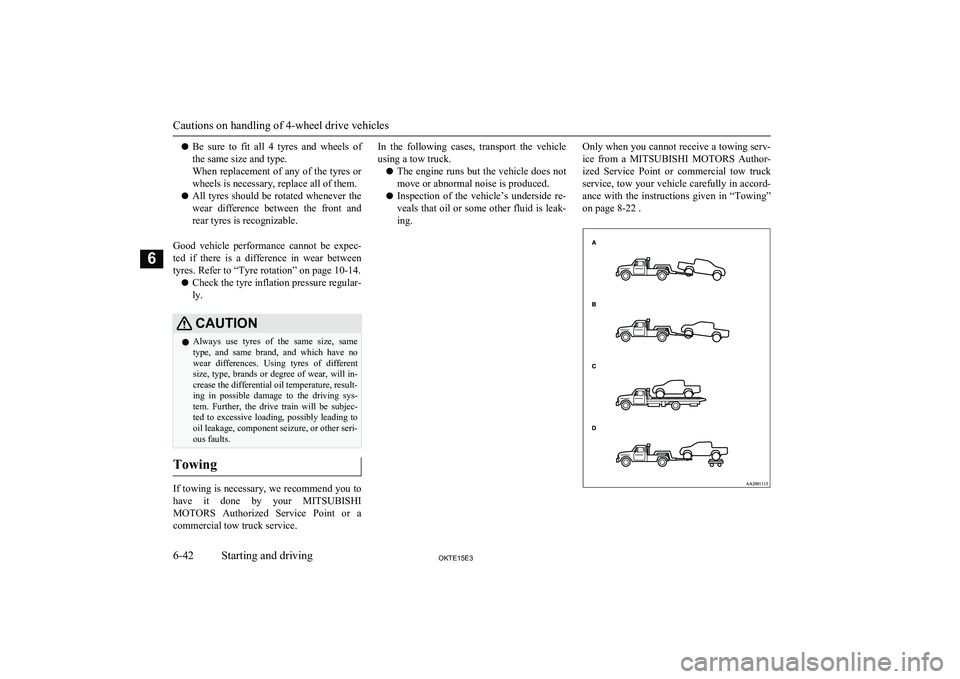
lBe sure to fit all 4 tyres and wheels of
the same size and type.
When replacement of any of the tyres or wheels is necessary, replace all of them.
l All tyres should be rotated whenever the
wear difference between the front and rear tyres is recognizable.
Good vehicle performance cannot be expec- ted if there is a difference in wear between
tyres. Refer to “Tyre rotation” on page 10-14.
l Check the tyre inflation pressure regular-
ly.CAUTIONl Always use tyres of the same size, same
type, and same brand, and which have no wear differences. Using tyres of different
size, type, brands or degree of wear, will in- crease the differential oil temperature, result-
ing in possible damage to the driving sys-
tem. Further, the drive train will be subjec-
ted to excessive loading, possibly leading to oil leakage, component seizure, or other seri-
ous faults.
Towing
If towing is necessary, we recommend you to
have it done by your MITSUBISHI
MOTORS Authorized Service Point or a
commercial tow truck service.
In the following cases, transport the vehicle
using a tow truck.
l The engine runs but the vehicle does not
move or abnormal noise is produced.
l Inspection of the vehicle’s underside re-
veals that oil or some other fluid is leak- ing.Only when you cannot receive a towing serv-ice from a MITSUBISHI MOTORS Author-
ized Service Point or commercial tow truck
service, tow your vehicle carefully in accord- ance with the instructions given in “Towing”
on page 8-22 .
Cautions on handling of 4-wheel drive vehicles
6-42OKTE15E3Starting and driving6
Page 325 of 418

Spare wheelE00801100094
The spare wheel is stored under the floor of the cargo bed.
A- Spare wheel
CAUTIONl When removing the spare wheel, put on
gloves. Removing the spare wheel with your
bare hands may cause injury to the fingers.CAUTIONl Check the air pressure of the spare wheel
frequently and make sure it is ready for
emergency use at any time.
Driving with an insufficient tyre pressure
can lead to an accident. If you have no choice but to drive with an insufficient tyre
pressure, keep your speed down and inflate the tyre to the correct pressure as soon as possible. (Refer to “Tyre inflation pressures”
on page 10-12.)
Maintaining the spare wheel at the highest
specified air pressure will ensure that it can always be used under any conditions (city/
high-speed driving, varying load weight,
etc.).
To remove
1. Set the jack handle. (Club cab, Double
cab with rear retractable power window
only)
(Refer to “To use the jack handle” on page 8-13.)
2. Insert the jack handle (A) in the hole (B)
below the rear gate.
3. Securely insert the pin (C) on the jack
handle into the holder (D) of the spare
wheel carrier.
Spare wheel
8-17OKTE15E3For emergencies8
Page 329 of 418
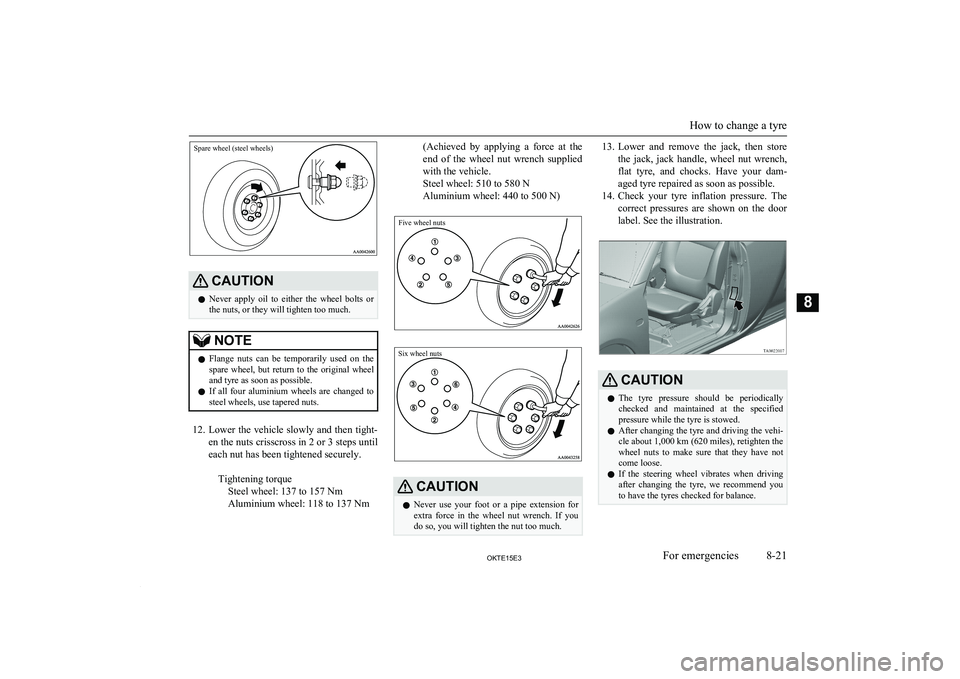
Spare wheel (steel wheels)
CAUTIONlNever apply oil to either the wheel bolts or
the nuts, or they will tighten too much.NOTEl Flange nuts can be temporarily used on the
spare wheel, but return to the original wheel and tyre as soon as possible.
l If all four aluminium wheels are changed to
steel wheels, use tapered nuts.
12. Lower the vehicle slowly and then tight-
en the nuts crisscross in 2 or 3 steps until
each nut has been tightened securely.
Tightening torqueSteel wheel: 137 to 157 Nm
Aluminium wheel: 118 to 137 Nm
(Achieved by applying a force at the
end of the wheel nut wrench supplied with the vehicle.
Steel wheel: 510 to 580 N
Aluminium wheel: 440 to 500 N)Five wheel nutsSix wheel nuts
CAUTIONl Never use your foot or a pipe extension for
extra force in the wheel nut wrench. If you
do so, you will tighten the nut too much.13. Lower and remove the jack, then store
the jack, jack handle, wheel nut wrench, flat tyre, and chocks. Have your dam-
aged tyre repaired as soon as possible.
14. Check your tyre inflation pressure. The
correct pressures are shown on the door label. See the illustration.CAUTIONl The tyre pressure should be periodically
checked and maintained at the specified pressure while the tyre is stowed.
l After changing the tyre and driving the vehi-
cle about 1,000 km (620 miles), retighten the
wheel nuts to make sure that they have not come loose.
l If the steering wheel vibrates when driving
after changing the tyre, we recommend you to have the tyres checked for balance.
How to change a tyre
8-21OKTE15E3For emergencies8
Page 334 of 418

Avoid racing the engine or spinning thewheels. Prolonged efforts to free a stuck ve-
hicle may result in overheating and transmis- sion failure. Allow the engine to idle for a
few minutes to let the transmission cool be-
tween rocking attempts.
If the vehicle remains stuck after several rocking attempts, seek other assistance.WARNINGl When attempting to rock your vehicle out
of a stuck position, be sure that the area
around the vehicle is clear of people and
physical objects. The rocking motion may cause the vehicle to suddenly launch for-ward or backward, causing injury or
damage to nearby people or objects.
On 2WD vehicles, it is recommended to start
the vehicle with parking brake partially, but
not completely, applied by slightly pulling the parking brake lever.
After the vehicle has become free, do not for-
get to release the parking brake.
NOTEl Depress the accelerator pedal gradually
when starting the vehicle.On a flooded road
l Avoid flooded roads. Water could enter
the brake discs, resulting in temporarily
ineffective brakes. In such cases, lightly
depress the brake pedal to see if the brakes operate properly. If they do not,
lightly depress the pedal several times while driving in order to dry the brake
pads.
l When driving in rain or on a road with
many puddles a layer of water may form between the tyres and the road surface.
This reduces a tyre’s frictional resistance
on the road, resulting in loss of steering stability and braking capability.
To cope with this, observe the following
items:
(a)Drive your vehicle at slow speed. (b)Do not drive on worn tyres. Al-
ways maintain the specified tyre
inflation pressures.On a snow-covered or frozen
road
l When driving on a snow-covered or fro-
zen road, it is recommended that you use snow tyres or tyre chains.
Refer to the “Snow tyres” and “Tyre
chains” sections.
l Avoid high-speed operation, sudden ac-
celeration, abrupt brake application and
sharp cornering.
l Depressing the brake pedal during travel
on snowy or icy roads may cause tyre
slippage and skidding. When traction be-
tween the tyres and the road is reduced the wheels may skid and the vehicle can-
not readily be brought to a stop by con- ventional braking techniques. Brakingwill differ, depending upon whether you
have anti-lock brake system (ABS). If you do have ABS, brake by pressing the brake system pedal hard, and keeping it
pressed. If you do not have ABS, pump
the brake pedal with short rapid jabs, each time fully applying and fully re-
leasing for greatest effect.
l Allow extra distance between your vehi-
cle and the vehicle in front of you, and avoid sudden braking.
Operation under adverse driving conditions
8-26OKTE15E3For emergencies8